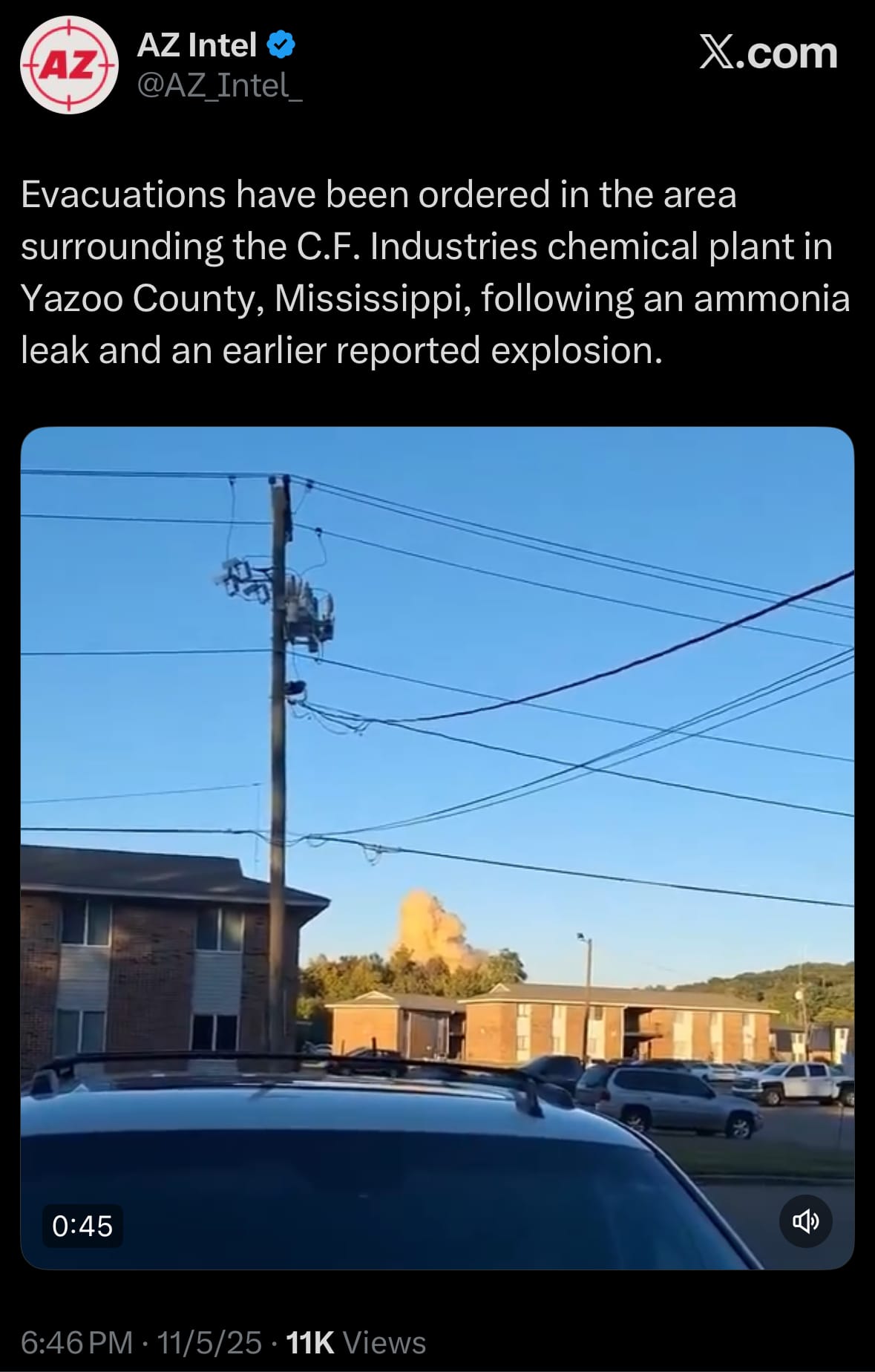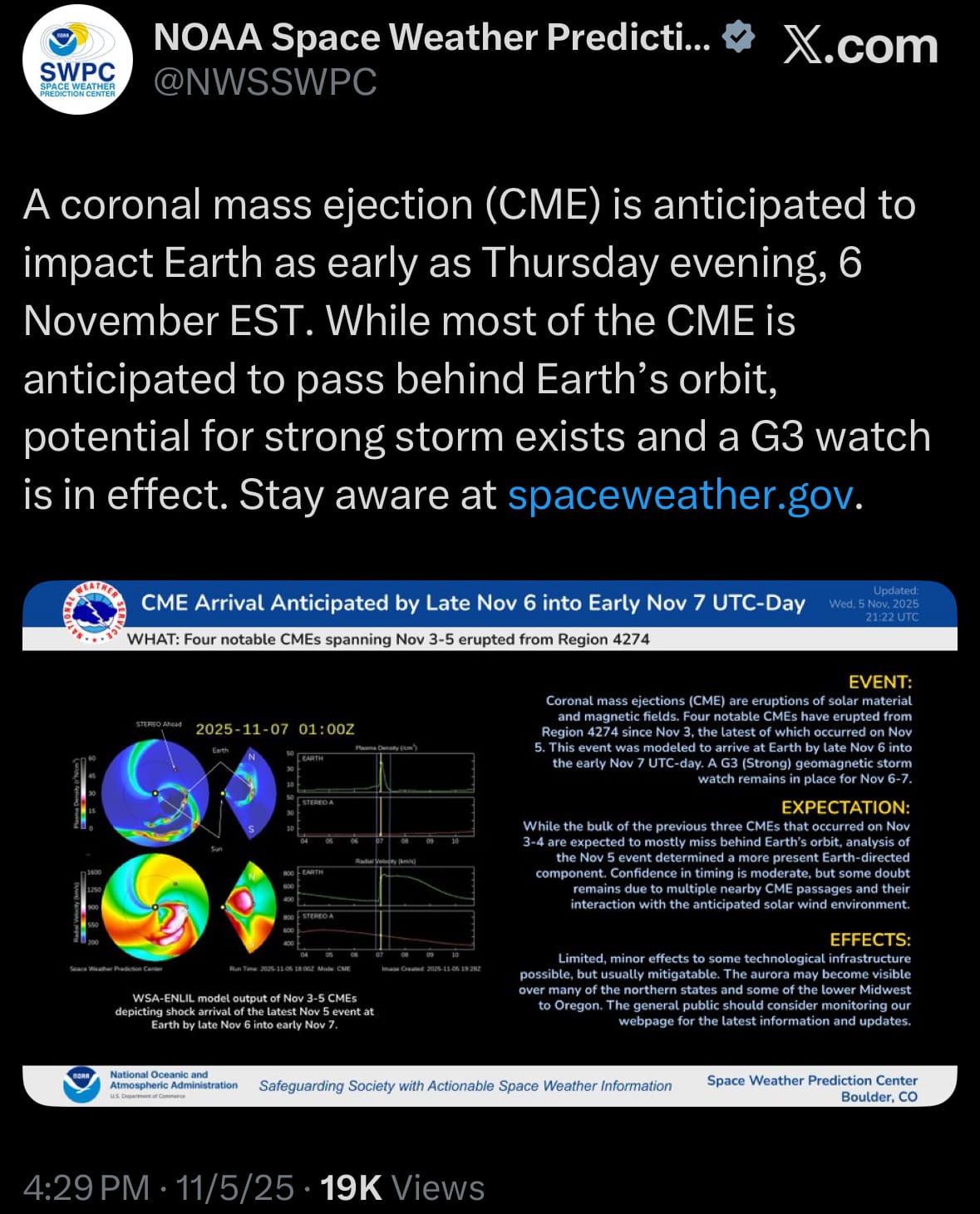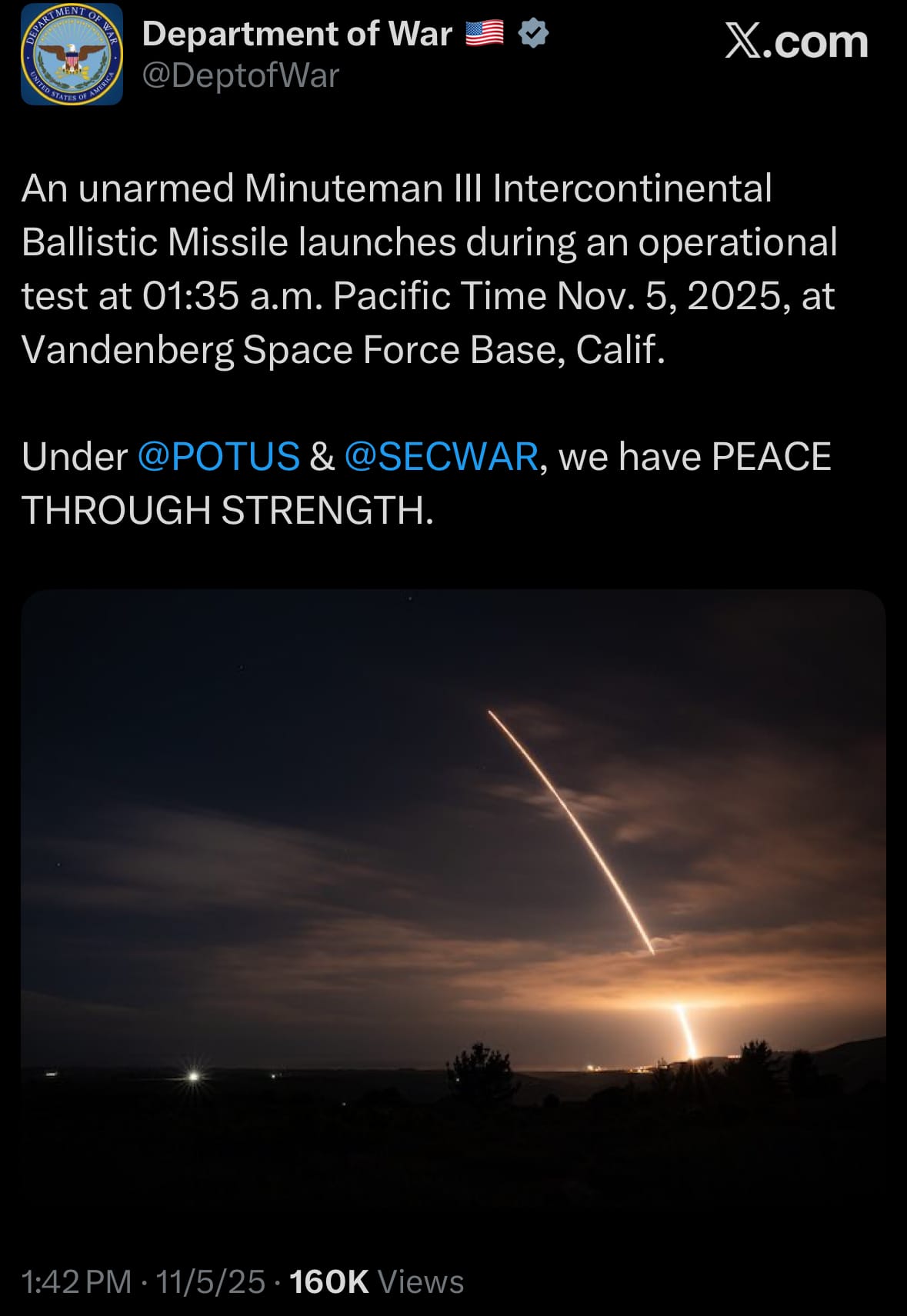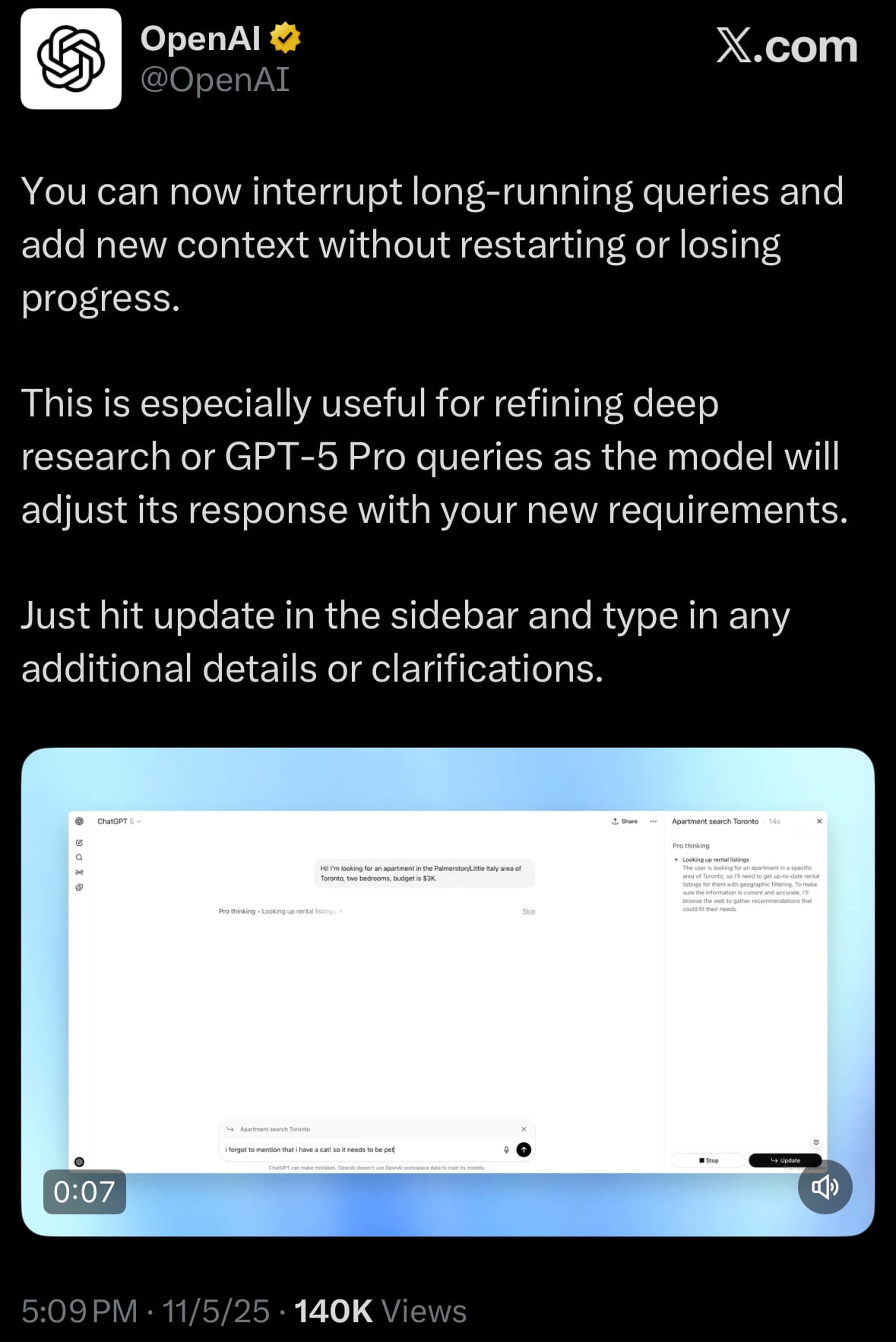Thursday☕️

Trending:
- On November 5, 2025, an explosion and ammonia leak occurred at the CF Industries chemical plant in Yazoo City, Yazoo County, Mississippi, leading to mandatory evacuations for residents and businesses within a one-mile radius of the site on U.S. 49 East. The event began around 4:25 p.m. local time, resulting in road closures including portions of Highway 49, and the deployment of local fire departments, hazmat teams, and state agencies to manage the leak and assess air quality. No injuries were reported initially, though officials recommended that those in the area relocate to safer distances or designated shelters, and nearby businesses such as a Walmart were evacuated as a preventive measure during ongoing evaluations.

- The plant, which produces nitrogen-based products including ammonia, is under investigation by the Occupational Safety and Health Administration and environmental authorities to identify the cause, potentially related to equipment or operational issues. Exposure to ammonia can cause respiratory problems, skin irritation, and environmental harm, raising immediate concerns for public health and local surroundings in this rural region. The incident illustrates safety risks associated with chemical facilities, which may lead to reviews of regulations and emergency planning while weighing their economic contributions against potential dangers.
Economics & Markets:
- Yesterday’s U.S. stock market:

- Yesterday’s commodity market:

- Yesterday’s crypto market:

Environment & Weather:
- On November 5, 2025, the National Oceanic and Atmospheric Administration's Space Weather Prediction Center (NOAA SWPC) issued a G3 (strong) geomagnetic storm watch for November 6 and 7 UTC, expecting a coronal mass ejection (CME) to arrive as early as Thursday evening EST. The CME stemmed from an M7.4 solar flare with a partial halo eruption early that morning, building on recent X-class flares, and is projected to sideswipe Earth, boosting geomagnetic activity. Alerts were sent for potential disruptions to satellite operations, GPS accuracy, and power grid stability, urging sectors like utilities and aviation to prepare, though no major impacts have occurred yet.

- Coronal mass ejections involve huge releases of solar plasma and magnetic fields from the Sun's corona, which can spark geomagnetic storms by disturbing Earth's magnetic field and upper atmosphere. Effects on technology may include radio blackouts affecting high-frequency communications for aircraft and ships, degraded satellite signals leading to navigation errors, and induced currents in power lines or pipelines risking outages or equipment damage. Other impacts could feature vivid auroras visible in mid-latitudes like Pennsylvania, Iowa, and Oregon, while the event during solar maximum emphasizes the need for robust forecasting via AI models to safeguard infrastructure, with outcomes varying based on the CME's magnetic alignment.
Geopolitics & Military Activity:
- On November 5, 2025, the U.S. Air Force Global Strike Command conducted an operational test launch of an unarmed Minuteman III intercontinental ballistic missile from Vandenberg Space Force Base in California, designated as GT 254, to validate the reliability and readiness of the nation's ICBM force. The missile was launched at approximately 1:35 a.m. local time, traveling over 4,200 miles to a test range in the Marshall Islands, with the test initiated by the Airborne Launch Control System as a demonstration of backup command capabilities.

- This routine exercise, planned months in advance, marked the 60th mission from Vandenberg in 2025 and involved coordination with the Space Launch Delta 30, emphasizing the system's accuracy and effectiveness without any reported anomalies. The Minuteman III, operational since the 1970s and the only land-based ICBM in the U.S. arsenal, forms a key component of the U.S. nuclear triad alongside submarine-launched and bomber-delivered weapons, capable of carrying multiple independently targetable reentry vehicles (MIRVs) with nuclear payloads over ranges exceeding 8,000 miles at hypersonic speeds.
Science & Technology:
- On November 5, 2025, Google announced the integration of its Gemini Deep Research feature with Google Workspace applications, enabling the AI tool to directly access and analyze data from Gmail, Google Drive, and Google Chat for more contextual and comprehensive research outputs. This update allows users to conduct in-depth queries that combine web searches with personal or organizational content, such as pulling insights from emails, documents, and conversations to generate reports, summaries, or analyses without manual data compilation.

- The feature, previously limited to web-based research, is now rolling out to all Gemini users on desktop via the Tools menu in the Gemini interface, with mobile support expected soon, marking a significant enhancement for productivity in professional environments. This development aims to streamline workflows for Workspace subscribers by fostering seamless AI-assisted decision-making, though it raises considerations around data privacy, as users must grant explicit permissions for app integrations, and potential reliance on AI for sensitive information handling.

Statistic:
- Largest assets on Earth by market capitalization:
- Gold: $27.685T
- 🇺🇸 NVIDIA: $4.752T
- 🇺🇸 Apple: $3.991T
- 🇺🇸 Microsoft: $3.769T
- 🇺🇸 Alphabet (Google): $3.433T
- Silver: $2.692T
- 🇺🇸 Amazon: $2.674T
- Bitcoin: $2.067T
- 🇺🇸 Broadcom: $1.695T
- 🇸🇦 Saudi Aramco: $1.671T
- 🇺🇸 Meta Platforms: $1.602T
- 🇺🇸 Tesla: $1.536T
- 🇹🇼 TSMC: $1.522T
- 🇺🇸 Berkshire Hathaway: $1.053T
- 🇺🇸 JPMorgan Chase: $848.45B
- 🇺🇸 Eli Lilly: $829.94B
- 🇺🇸 Walmart: $809.00B
- 🇺🇸 Vanguard S&P 500 ETF: $794.99B
- 🇨🇳 Tencent: $739.09B
- 🇺🇸 iShares Core S&P 500 ETF: $714.41B
- 🇺🇸 Oracle: $713.58B
- 🇺🇸 SPDR S&P 500 ETF: $699.14B
- 🇺🇸 Visa: $657.38B
- 🇺🇸 Vanguard Total Stock Market ETF: $559.32B
- 🇺🇸 Mastercard: $496.87B
History:
- Intercontinental Ballistic Missiles (ICBMs) emerged from the post–World War II fusion of rocket science and geopolitics. The concept’s roots lie in Germany’s V-2 rocket program, which proved long-range, high-altitude ballistic flight was possible. After the war, both the United States and the Soviet Union absorbed German engineers and research, setting off a technological rivalry that would define the nuclear age. The Soviet R-7 Semyorka, launched in 1957, became the first operational ICBM, and its derivative rocket even launched the first satellite, Sputnik. The United States followed with the Atlas and Titan series, paving the way for a credible nuclear deterrent. These early missiles were cumbersome and liquid-fueled, but the development of solid-fuel technology in the 1960s—exemplified by America’s Minuteman series—transformed ICBMs into rapid-response systems that could remain launch-ready for decades. Over time, both superpowers developed vast underground networks, command systems, and early warning technologies to ensure their deterrents were survivable and credible.
- Modern ICBMs now combine immense range with extraordinary precision and complexity. A defining leap came with the invention of Multiple Independently Targetable Reentry Vehicles (MIRVs), allowing one missile to release several nuclear warheads that can strike different targets. U.S. Minuteman IIIs typically carry up to three warheads, while Russian systems such as the RS-24 Yars and RS-28 Sarmat can carry between ten and fifteen, and China’s DF-41 is believed to carry up to ten. Russia’s designs emphasize payload capacity and defense evasion, incorporating potential hypersonic glide vehicles to penetrate modern intercept systems. China’s program, which began more modestly, has advanced rapidly with mobile launchers and silo-based systems designed to ensure second-strike capability. The United States continues to modernize its own deterrent, with the LGM-35A Sentinel program replacing aging Minuteman IIIs and parallel development of hypersonic systems to enhance responsiveness. Together, these arsenals represent the culmination of seventy years of technological evolution—machines designed less for use than for the perpetual maintenance of an uneasy peace through balance and restraint.
Image of the day:

Thanks for reading!
- EARTH INTELLIGENCE builds private intelligence systems for organizations — connecting their internal and external data with AI to create one interactive command center for real-time awareness, decision making, and predictions.
Earth is complicated, we make it simple.
- Click below if you’d like to view our free EARTH WATCH globe:


Click below to view our previous newsletters:

Support/Suggestions Email:
earthintelligence@earthintel.news




